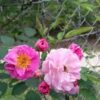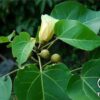Conserving Biodiversity with Rosa cymosa

Rosa cymosa, with its diverse genetic makeup and ecological significance, plays a crucial role in biodiversity conservation efforts worldwide. Part 1 of our exploration will delve into the importance of preserving biodiversity, the ecological value of Rosa cymosa, and the conservation strategies employed to safeguard its genetic diversity and natural habitats.
### 1. Importance of Biodiversity Conservation
#### Ecosystem Stability
Biodiversity is essential for maintaining ecosystem stability and resilience, as it ensures the balance of ecological processes, such as nutrient cycling, pollination, and pest control. By preserving diverse plant species like Rosa cymosa, we help sustain healthy ecosystems that provide vital services, including clean air and water, fertile soils, and climate regulation, upon which all life depends.
#### Genetic Resources
Rosa cymosa serves as a valuable genetic resource for breeding programs aimed at developing new rose varieties with enhanced traits, such as disease resistance, fragrance, and bloom longevity. By conserving the genetic diversity of Rosa cymosa and its wild relatives, we ensure the availability of genetic material for future breeding efforts, helping to address emerging challenges in agriculture, horticulture, and environmental restoration.
### 2. Ecological Value of Rosa cymosa
#### Habitat Diversity
Rosa cymosa is found in a variety of habitats, ranging from open woodlands and meadows to rocky slopes and stream banks. Its adaptability to diverse environmental conditions makes it a valuable component of many ecosystems, providing food and shelter for wildlife, stabilizing soil, and preventing erosion, and contributing to the overall biodiversity and resilience of natural landscapes.
#### Pollinator Support
The flowers of Rosa cymosa attract a wide range of pollinators, including bees, butterflies, and hoverflies, making it an important source of nectar and pollen for native pollinator species. By supporting pollinator populations, Rosa cymosa enhances the reproductive success of other plant species and promotes biodiversity in surrounding habitats, ultimately contributing to the health and stability of entire ecosystems.
### 3. Conservation Strategies
#### Protected Areas
Establishing protected areas, such as nature reserves, national parks, and wildlife sanctuaries, is a key conservation strategy for safeguarding the natural habitats of Rosa cymosa and other plant species. These protected areas provide vital refuges where native flora and fauna can thrive free from human disturbance, ensuring the long-term survival of biodiversity hotspots and ecologically sensitive areas.
#### Habitat Restoration
Habitat restoration efforts aim to rehabilitate degraded ecosystems and reestablish suitable habitats for Rosa cymosa and other native plant species. By removing invasive species, restoring native vegetation, and implementing sustainable land management practices, conservationists can create healthier and more resilient habitats that support the growth and proliferation of Rosa cymosa and its associated biodiversity.
### 4. Conclusion
Part 1 of our exploration has highlighted the importance of conserving biodiversity with Rosa cymosa, emphasizing its ecological value and the need for effective conservation strategies to protect its genetic diversity and natural habitats. By recognizing the intrinsic link between biodiversity conservation and ecosystem health, we can work together to ensure a sustainable future for Rosa cymosa and the countless other species that depend on diverse and resilient ecosystems to thrive. In Part 2, we will delve deeper into the specific conservation initiatives and collaborative efforts aimed at preserving Rosa cymosa and its unique contributions to global biodiversity.
**Conserving Biodiversity with Rosa cymosa: Part 2**
In Part 1, we explored the significance of conserving biodiversity with Rosa cymosa, emphasizing its ecological value and the importance of conservation strategies to protect its genetic diversity and natural habitats. Continuing our exploration, Part 2 will delve deeper into the specific conservation initiatives, collaborative efforts, and challenges associated with preserving Rosa cymosa and its unique contributions to global biodiversity conservation.
### 1. Conservation Initiatives
#### Ex Situ Conservation
Ex situ conservation involves the preservation of plant species outside their natural habitats, often in botanical gardens, arboreta, or seed banks. Several institutions around the world maintain collections of Rosa cymosa germplasm, including living specimens, seeds, and tissue cultures, to safeguard its genetic diversity and ensure its availability for future research, breeding, and reintroduction programs.
#### In Situ Conservation
In situ conservation focuses on the protection and management of Rosa cymosa populations in their natural habitats, where they are subject to ongoing threats such as habitat loss, fragmentation, and degradation. Conservation organizations and government agencies work to establish protected areas, implement habitat restoration projects, and monitor populations to ensure the long-term survival of Rosa cymosa and its associated biodiversity.
### 2. Collaborative Efforts
#### International Collaboration
International collaboration is essential for addressing the global challenges of biodiversity conservation and climate change. Organizations such as the International Union for Conservation of Nature (IUCN), the Convention on Biological Diversity (CBD), and the Global Environment Facility (GEF) facilitate collaboration between governments, NGOs, and scientific institutions to coordinate conservation efforts, share knowledge and resources, and develop strategies for protecting Rosa cymosa and other threatened plant species.
#### Community Engagement
Engaging local communities in conservation efforts is crucial for ensuring the success and sustainability of biodiversity conservation initiatives. By involving communities in habitat restoration projects, environmental education programs, and sustainable livelihood opportunities, conservationists can build support for conservation goals, empower local stakeholders to take ownership of their natural resources, and foster a sense of stewardship and pride in protecting Rosa cymosa and its habitats.
### 3. Challenges and Future Directions
#### Habitat Loss and Fragmentation
Habitat loss and fragmentation are major threats to the survival of Rosa cymosa and other plant species, driven by factors such as urbanization, agricultural expansion, and infrastructure development. To address these challenges, conservationists must prioritize habitat conservation, land-use planning, and sustainable development practices that minimize the impact of human activities on natural ecosystems and ensure the connectivity and resilience of Rosa cymosa populations.
#### Climate Change
Climate change poses additional challenges to the conservation of Rosa cymosa and its habitats, as rising temperatures, changing precipitation patterns, and extreme weather events alter ecosystem dynamics and disrupt plant-pollinator interactions. Conservationists must develop climate-resilient conservation strategies, such as assisted migration, assisted evolution, and genetic adaptation, to help Rosa cymosa and other species adapt to rapidly changing environmental conditions and thrive in a warmer, more unpredictable climate.
### 4. Conclusion
Part 2 of our exploration has shed light on the specific conservation initiatives, collaborative efforts, and challenges associated with preserving Rosa cymosa and its unique contributions to global biodiversity conservation. By implementing effective conservation strategies, engaging local communities, and addressing emerging threats such as habitat loss and climate change, we can ensure the long-term survival of Rosa cymosa and safeguard its invaluable genetic diversity and ecological legacy for future generations to enjoy and appreciate. Together, we can make a difference in conserving biodiversity and protecting the natural world we all depend on for our health, prosperity, and well-being.


